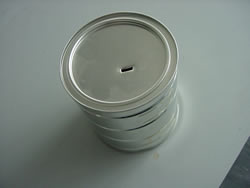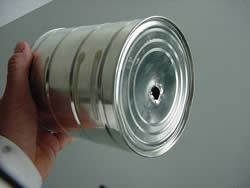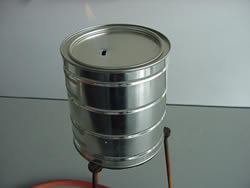Obtain a large empty tin of coffee and make a small hole in the lid.

Make a hole at the base of the tin large enough to fit a rubber tube.



Carefully remove the rubber tubing from the base of the tin and close the tap.

As the gas slowly moves out of the tin and oxygen moves in, the number of methane and oxygen molecules reaches a critical ratio. At this ratio enough collisions occur between gas and oxygen molecules to cause the mixture to explode
Safety precautions.
Students should be at least 5 metres from the tin. Do not approach any tin that has not spontaneously ignited. Let the tin stand for 15 minutes before approaching.
Explanation .
Gas (methane (CH4 ) is less dense than air, so it rises inside the can. It burns at the methane-air interface. The buoyant force of air acting on the gas forces it upwards. The hole at the bottom of the can allows air to move in, pushing the layer of gas upwards.
As the amount of gas in the can decreases so does the speed with which it moves upwards. This is because the buoyant force of air acting on the gas is directly related to the volume of methane gas. This allows the flame to fall below the level of the can and ignite the air-gas mixture that has accumulated inside the can. You will notice that the flame changes to a more blue colour as it burns longer. A blue colour indicates an oxygen rich fuel mixture.

1) How does the flame change colour throughout the course of the demonstraiton? Explain why.
Explain why using your knowledge of how you change a Bunsen Burner flame from yellow to blue.
2) Air is composed of 79% N2 and about 21% O2. Out of methane and air which is more dense?
3) How does the methane gas travel up through the can to the hole at the top where it is burnt?
4) Why does the flame get smaller as time passes?
5) Over time the speed of the gas escaping the top hole
6) Since the can is filled with gas why does it not explode when the flame is first lit?
7) How would this demonstration change if the holes were of different size?
8) Spilling petrol in a closed room may lead to an explosive mixture as the petrol evaporates. Explain why with reference to this demonstration.